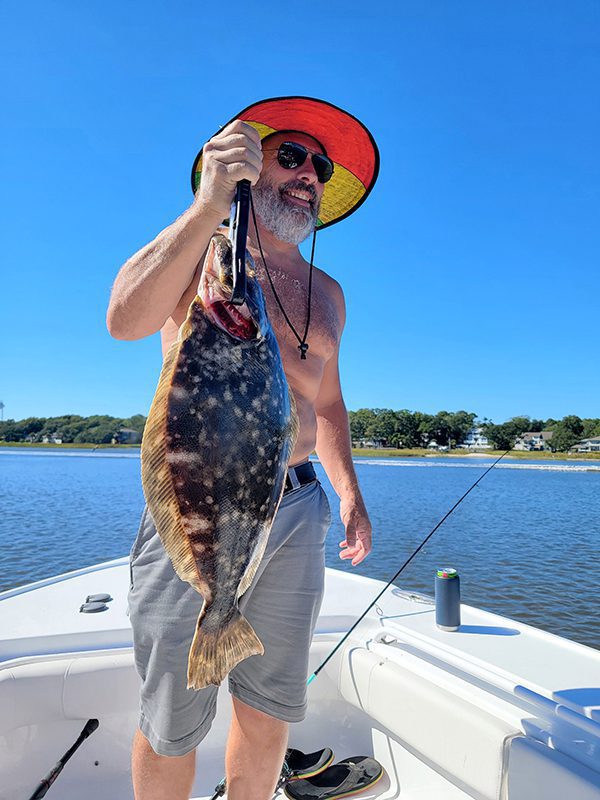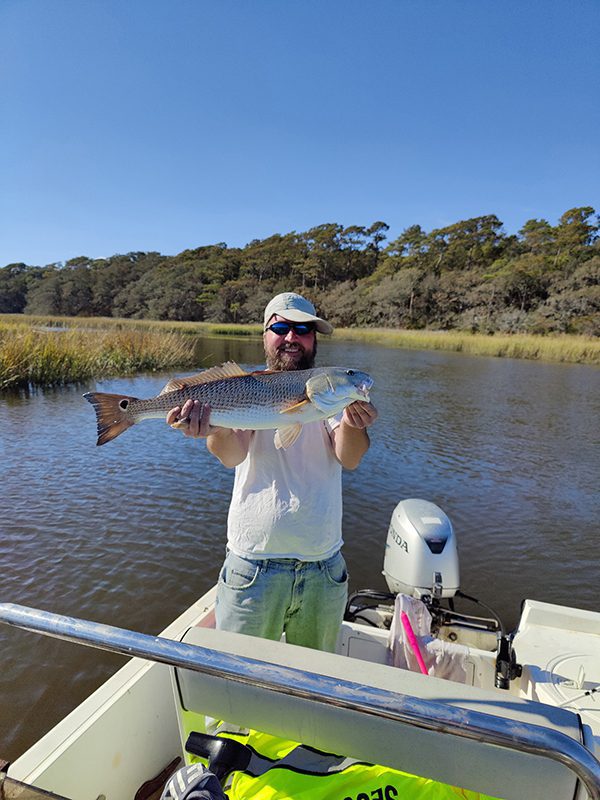North Myrtle Beach/Little River – November 2022
Patrick, of Captain Smiley Fishing Charters, reports that the speckled trout bite has started to pick up for anglers fishing the northern end of the Grand Strand. These schools are holding in deeper areas (5-10’ depths) of certain creeks. Drifting a live shrimp under a float around 4’ down in the water column should help anglers hook up.
This same tactic is also producing black drum bites when the bait gets closer to the bottom.
There is an abundance of lower-slot red drum around, and they are also hitting the same live shrimp setup. These reds will be in the deeper areas of creeks as well, preferring potholes further back, feeder creeks, grass edges, and rocks. Anglers targeting the reds can have a lot of success with live finger mullet or Gulp baits on heavier (3/8 oz.) jig heads.
Anglers looking for some bull red drum are still finding a couple, but most have moved on with the passing cold fronts. Overall, it was a slower season than years past, with anglers generally needing to put in a bunch of hours to hook 1-2 fish. If looking for action, it has been best to target 20-30’ depths with cut or live mullet and menhaden.

Neil Colville caught this 5.75 lb. flounder using a mullet minnow in the Ocean Isle ICW.
Bob, of Strange Magic Fishing Charters, reports that the speckled trout bite has finally started kicking off in fall fashion. Anglers are having a lot of success targeting spots in the ICW where shell banks transition to grass. A nearby marsh drain or emptying creek, as well as the presence of bait and/or birds, adds a bonus to chances of success. Cast netting some live shrimp and fishing under a popping cork has worked to get these fish to actively feed. Live minnows and soft plastics are also having plenty of success.
The annual bull redfish run out at the Little River jetties has been a bit slow and spotty this year.
Flounder are still being caught back in the creeks and backwater holes.
Slot-sized red drum are staged up in smaller groups throughout the creeks. Look for these fish far back in the creeks on higher tides, and then work the banks closer to the mouths of creeks as tides fall and get to peak low.
Black drum are scattered around but not in any great numbers. A live or fresh dead shrimp will provide the best chance of action when fished around docks and deeper holes back in the creeks.
Chris, of Fine Catch Fishing Charters, reports that nearshore ledges in the 10-20 mile range are still holding good numbers of grouper. Live pinfish or pogies on a grouper rig seem to be working best. Don’t be surprised to be catching a bunch of red snapper as well, and have a pitch rod ready in case a curious cobia shows up around the boat.
The nearshore bite has been a bit slow for flounder fishing. It seems these flatfish are still in their transition inshore. This should change as another push of fish head out to the reefs.
At the jetties there is a bit of a bull red drum bite going on. The best action has been between two hours of each side of the high and low tides. Live pogies are best if you can find them, but anglers will also have success with small croakers and fresh dead pogies.
Fishing tighter to the jetty rocks with live shrimp under slip corks is producing speckled trout and smaller redfish.
In the backwater creeks, there have been some small red drum staged up in potholes. Anglers are typically using some variety of live mullet, live shrimp, or artificials such as Vudu shrimp and Gulp baits on jig heads.
The deeper channels leading back to these holes have seen a push of trout in the 13-22” range. Rigging a slip cork with live shrimp will produce some bites, and this same tactic will also produce flounder and black drum.
Anglers fishing the ICW are finding bigger red drum in channels around structure. They’ve been feeding on finger mullet or pogies hooked on Carolina rigs.
These same ICW channels are also holding black drum for those fishing live or dead shrimp on the bottom, but there are still plenty of pinfish and croakers around to steal these baits.
Speckled trout are staged up around shell banks and creek mouths along the ICW. Focus efforts around grass banks and shell banks on higher tides by drifting live shrimp.
Bevan, of Chilly Water Fishing, reports that bottom fish are moving up into shallower waters. Good-sized black sea bass are being found in the 50-60’ range and grouper in the 75’ area.
Vermilion snapper are still holding a bit deeper (80’+), with triggers and pinkies still favoring the deeper water outside of that.
There is still tons of bait out around the bottom structure, so keep a live bait out, either free-lined or under a cork, for the chance of kings and even the occasional late season mahi.

Neil Huddleston, of Roanoke, VA, caught this red drum on finger mullet in Dunn Sound.
Larry, of Voyager Fishing Charters, reports that the bottom fishing action is moving shallower, but the 120’ range is still the most productive bottom around. There are tons of vermilion snapper, triggerfish, grunts, porgies, and more in the 120’ range.
Drift lines out in this zone have been producing some nice-sized king mackerel and mahi.
Trolling trips headed offshore are catching some wahoo and blackfin tuna.
Nearshore bottom fishing continues to kick out good numbers of black sea bass and porgies.
There are schools of spanish mackerel off the beach still, and they are now joined by some false albacore.
Samantha, of Apache Pier, reports that though the very end of the pier sustained damage, anglers are seeing some good bottom fishing. Some of the bigger whiting have started to show up, and they are mixed in with black drum and croakers.
Anglers doing some plugging are catching spanish mackerel, though cooler weather over the next few weeks should push the rest of the spanish out of the area.





